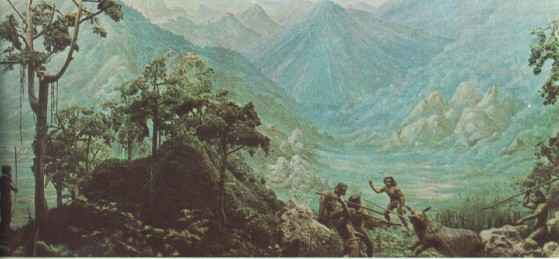According to Ayala Museum's "History of the Philippines" the Philippines pre-history began as early as 500,000 years ago, in a period characterized by the "enlargement of the ice caps in the polar region and the glaciers in the mountainous areas". As they grew larger, the sea level went down causing land bridges to emerge, thereby linking the Asian continent to outlying islands, including those of the Philippine Archipelago.
From the Asian mainland, man (of the Homo erectus variety) and animal crossed over to the Philippines on these land bridges, specifically over the old connections between Formosa and Luzon.
That man already appeared in the country at about this time is indicated by the discoveries of stone tools in association with pre-historic animals such as elephas, stegodon, rhinoceros, giant tortoises and crocodiles, in Cagayan Valley. These man-made tools, consisting of river pebble or cobble tool and the flake or flake core too, belong to a hunting and gathering cultures.
It was in this corridor in the North where these animals, hemmed in by the high mountains in the East, west and south were finally killed off by man.
If hunters came to the Valley from the North then we can speculate that they followed the Cagayan River down south to Nueva Vizcaya. These are probably the ancestors of the indigenous people of Magat River and the great builder of the Rice Terraces. It is only fair to say that the natural history of the Philippines started in the valley.
Nestor Palugod Enriquez, Southern Nueva Vizcaya Institute History Class
Picture from Ayala Museum “History of the Philippines”
 100,000 Years in the Valley
100,000 Years in the Valley
The National Museum Annual Report recently revealed some interesting work done in the Cagayan Valley by Kazuhiko Tanaka. His team found some interesting indigenous pottery sites at Pamittan. Storage jars, bowls, cooking vessels, earthenwares, clay ornaments, clay earrings and spindle whorls were found. Charcoal samples taken in situ were tested at the Gakushuin Radiocarbon Laboratory in Tokyo and gave dates of 1860 200+- B.C. for one sample, and 1440 +-100 B.C. for another. This would make Pamittan comtemporaneous with the Lapita period of the Pacific region. The work at Pamittan is a joint undertaking by the National Museum and the Japanese Ministry of Education. (Nat. Museum Ann. Rep. 1994, p. 14)
An older but fascinating find comes from the Bolobok Rockshelter excavation in Tawi Tawi. The work was done by Wilfredo P. Ronquillo, Kazuhiko Tanaka, Rey Santiago and Shijun Asato. The most interesting find comes from what is described as a "late occupational phase", which is dated to 3,190 B.C. Among
the artifacts found at this level were a socketed bronze adze and opaque glass bead. This marks a much earlier age for bronze in the Philippines even if this object was introduced by an intruding element. The oldest dating for bronze from the Near East is about 3,000 B.C.; 2,000 B.C. for Mohenjo Daro in South
Asia, and the oldest dated bronze is 3,600 B.C. from Ban Chiang in Thailand. It will be interesting to see if this date for bronze can be verified from other in situ finds. From the middle occupational phase, dated at 5340 B.C., polished stone tools were found suggesting woodworking and, possibly, boat making
activities (Nat. Museum Ann. Rep. 1993, p. 19). Contributed by Paul Manansala.